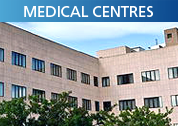
Specialized Centers
HOSPITAL CLÍNICA BENIDORM (HCB)
HOSPITAL CLÍNICO VISTAHERMOSA
HOSPITAL INTERNACIONAL MEDIMAR
Arthrodesis (fusion) of the Cervical or Lumbar Spine
The vertebral segment is the basic functional unit of the spine. It consists of two adjacent vertebrae, the intervertebral disc and all the ligaments that balance them and allow mobility.
Degenerative changes, trauma, infection, tumours, etc. may cause deterioration of one or several vertebral segments, leading to:
- Back pain due to biomechanical vertebral changes (instability/deformation)
- Back pain due to degeneration of the segment (joint/disc)
- Compression of the medulla or nerves caused by stenosis (narrowing) of the spinal canal.
Arthrodesis is irreversible and consists of fusing the bones of one or more vertebral segments to relieve back pain and prevent or treat instability. It can be associated with a decompression of the spinal canal, if necessary.
Benefits of the Operation
The purpose of fusion is to stabilise the spinal column to relieve local pain. Decompression of the nerve roots relieves sciatic pain and difficulty walking caused by stenosis of the canal.
In the case of spinal cord damage, symptoms such as weakness and numbness may take some time to remit or may remain as sequelae (conditions resulting from an earlier disease or illness), depending on the extent of the damage.
Medical-technical description
- ANTERIOR CERVICAL ARTHRODESIS: a minimally invasive procedure performed by making a transversal incision in the front of the neck. Discs are replaced by implants or the patient's own bone. Screw-in plates are used to correct the curvature.
- POSTERIOR CERVICAL ARTHRODESIS: A more aggressive approach is used with a longitudinal incision in the back of the neck. The spinal canal and cervical nerves are decompressed without manipulating the discs. Screws and bars are used to fix them in place.
- THORACIC/LUMBAR POSTERIOR ARTHRODESIS: standard approach for spinal canal decompression using pedicle screws and rods usually made of titanium, for stability. Bone grafts are either transplanted directly from the patient's own skeleton or synthetic material is used.
- LATERAL LUMBAR INTERNODY FUSION (XLIF): this approach is minimally invasive to the spinal column. All healthy spinal structures are left intact. The procedure is performed through the psoas muscle, and can cause some weakness, which may or not be transitory, in the leg. It is no possible in L5-S1
- AXIA-LIF: percutaneous approach specifically designed for L5-S1.
- OPTIMESH LUMBAR INTERBODY FUSION (OLIF): Minimally invasive, oblique approach to the spinal column with little risk, but only valid from L2 to L5
- ANTERIOR LUMBAR INTERBODY FUSION (ALIF): Anterior approach to the spinal column. High guarantees for intersomatic fusion. Higher vascular risk than other techniques.
About the operation
Vertebral arthrodesis or spinal fusion takes place in the operating theatre under general anaesthetic. The procedure usually takes between one and five hours, depending on the type of approach used and the location, although the patient is in the operating theatre and recovery room for between three and seven hours.
Patients must stay in hospital for between one and 10 days.
Before the operation
- The patient goes to the doctor's office for a prior consultation, where decisions are taken and the doctor will explain the surgery in detail and give the patient an informed consent.
- The patient has a complete preoperative study with laboratory tests, ECG and x-rays.
- Do not drink alcohol or smoke for 48 hours before the procedure.
- If you are to have your surgery in the morning, you must not eat or drink anything that morning. If the surgery is to take place in the afternoon, have an early breakfast then do not eat or drink anything after 9 am.
- You must remove all metal objects during the operation (rings, bracelets, earrings, body piercings, etc.).
Post-operative care
- You will need help to change position in bed and you should preferably lie on your side.
- Any drains will be removed between 24 and 48 hours after the operation.
- Generally, patients get out of bed on the day after surgery.
- Use of ortheses after the operation
- Patients having a lumbar or thoracic fusion will be asked to wear a corset for two months, except when sleeping.
- Cervical fusion does not require the use of an orthesis, unless you are told to do so otherwise.
- Restricted mobility after surgery
- You must walk on the days after a lumbar or thoracic fusion, being careful not to tire your back. You will be able to walk longer distances progressively. Use straight backed chairs while you are wearing the corset.
- After a surgical fusion you can move your neck normally, but never make sudden movements.
- After you have been released:
- For the next two months you must avoid lifting weights, crouching down, bending or straining the spine in any difficult positions, sport, housework and driving.
- You should contact us if you notice any chest pain or are short of breath, feel weakness in any of your limbs, have a fever or shivering or discharge from the wound.
- Your doctor will recommend physiotherapy or rehabilitation. Sometimes you will need medical treatment.



